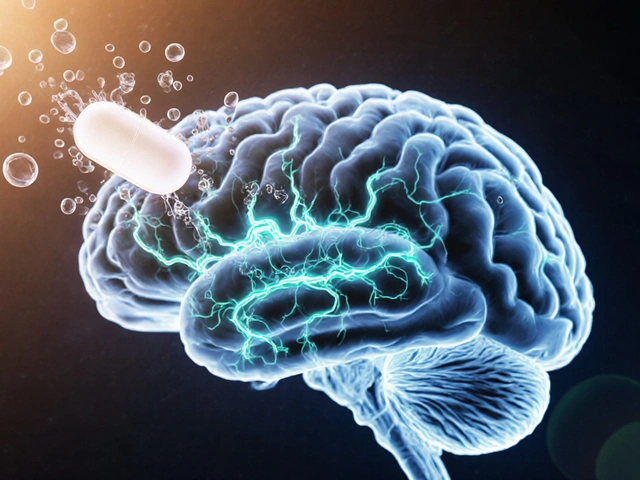
Antipsychotic Medication Selector
How to Use This Tool
Select your primary concerns and we'll suggest which antipsychotic might be most suitable for you.
Recommended Medication:
When a psychiatrist prescribes an antipsychotic, the choice isn’t just about brand names-it's about matching a medication’s chemistry to a patient’s symptoms, lifestyle, and health history. Risperdal (risperidone) remains a go‑to drug for schizophrenia and bipolar disorder, but dozens of newer and older options compete for the same slot. This guide walks you through the most common alternatives, laying out how they differ in mechanism, dosing, side‑effects, and real‑world tolerability, so you can feel confident about the next step.
Key Takeaways
- Risperdal blocks dopamine D2 and serotonin 5‑HT2A receptors, offering strong efficacy with a moderate side‑effect profile.
- Aripiprazole (Abilify) works as a dopamine partial agonist, often producing fewer metabolic changes.
- Quetiapine (Seroquel) is sedating and useful for mood stabilization but can cause weight gain.
- Olanzapine (Zyprexa) is highly effective but carries the highest risk of metabolic syndrome.
- Choosing the right drug hinges on individual factors: age, comorbidities, tolerance, and personal preference.
What Is Risperdal (Risperidone)?
Risperdal is a second‑generation (atypical) antipsychotic that was first approved by the FDA in 1993. It blocks dopamine D2 receptors and serotonin 5‑HT2A receptors, reducing psychotic symptoms while limiting the harsh motor side‑effects typical of first‑generation drugs. The drug comes in tablets, orally disintegrating tablets (ODT), and a long‑acting injectable (Risperdal Consta) that ships once a month for patients who struggle with daily dosing.
Typical oral dosing starts at 1mg daily for adults and can be titrated up to 6mg per day, depending on response and side‑effect tolerance. The injectable formulation delivers an equivalent of 25mg per month.
How Does Risperdal Work?
Risperidone’s dual‑action on dopamine D2 and serotonin 5‑HT2A receptors helps balance the neurotransmitter storm that underlies hallucinations, delusions, and mood swings. By dampening dopamine in the mesolimbic pathway, it curbs positive psychotic symptoms; the serotonin blockade mitigates some of the negative symptoms and reduces the risk of extrapyramidal side‑effects (EPS).
Key pharmacokinetic facts:
- Peak plasma concentration: 1-2hours after oral ingestion.
- Half‑life: ~3hours (active metabolite paliperidone extends effects up to 23hours).
- Metabolized mainly by CYP2D6; genetic poor metabolizers may need dose adjustments.

Top Alternatives to Risperdal
The following drugs are the most frequently prescribed when clinicians look for a substitute or adjunct to risperidone. Each alternative has its own pros, cons, and niche uses.
Aripiprazole (Abilify)
Aripiprazole is a dopamine‑system stabilizer that acts as a partial agonist at D2 receptors, while also antagonizing 5‑HT2A receptors. This unique mechanism often translates into fewer metabolic side‑effects and a lower risk of EPS.
- Approved for schizophrenia, bipolar I mania, and as augmentation for major depressive disorder.
- Typical dose: 10-30mg daily; can be given as a once‑monthly injection (Austedo).
- Common side‑effects: insomnia, akathisia (restlessness), mild weight gain.
- Metabolic risk: low to moderate.
Quetiapine (Seroquel)
Quetiapine is a broad‑spectrum atypical antipsychotic that blocks D2, 5‑HT2A, and histamine H1 receptors, giving it a calming, sedating profile.
- Uses: schizophrenia, bipolar depression, off‑label for anxiety and insomnia.
- Typical dose: 150-800mg daily, divided BID or TID.
- Common side‑effects: drowsiness, orthostatic hypotension, weight gain.
- Metabolic risk: moderate to high, especially at doses >600mg.
Olanzapine (Zyprexa)
Olanzapine is known for its strong efficacy in both positive and negative symptoms of schizophrenia, but it carries the highest propensity for metabolic disturbances.
- Approved for schizophrenia and bipolar I mania.
- Typical dose: 5-20mg daily; also available as a long‑acting injection (Zyprexa Relprevv).
- Common side‑effects: significant weight gain, hyperglycemia, dyslipidemia.
- Metabolic risk: high; patients often need baseline and quarterly labs.
Ziprasidone (Geodon)
Ziprasidone combines dopamine D2 antagonism with serotonin 5‑HT2A/5‑HT1A activity, offering a relatively weight‑neutral option.
- Uses: schizophrenia and acute manic or mixed episodes of bipolar disorder.
- Typical dose: 20-80mg twice daily, taken with food.
- Common side‑effects: nausea, QT‑prolongation (requires ECG monitoring), mild akathisia.
- Metabolic risk: low.
Haloperidol (Haldol)
Haloperidol is a first‑generation antipsychotic, still valuable for acute agitation or when a patient cannot tolerate atypicals.
- Mechanism: pure D2 antagonist.
- Typical dose: 0.5-5mg twice daily; long‑acting injectable available.
- Common side‑effects: high EPS risk (tremor, rigidity), tardive dyskinesia with long‑term use.
- Metabolic risk: low, but neuro‑muscular side‑effects are prominent.
Side‑Effect Comparison Table
| Medication | Weight Gain | EPS / Akathisia | Metabolic Syndrome | QT‑Prolongation |
|---|---|---|---|---|
| Risperdal | Moderate | Low‑moderate | Low‑moderate | Rare |
| Aripiprazole | Low | Low (may cause akathisia) | Low | Rare |
| Quetiapine | High | Low | Moderate‑high | Rare |
| Olanzapine | High | Low | High | Rare |
| Ziprasidone | Low‑moderate | Low | Low | Potential (requires ECG) |
| Haloperidol | Low | High | Low | Rare |
Decision Checklist: When to Stay on Risperdal vs. Switch
- Symptom control: If risperidone is effectively reducing hallucinations or mania without severe side‑effects, continuation is reasonable.
- Weight concerns: Patients gaining >5kg in the first 3 months may benefit from aripiprazole or ziprasidone.
- Movement disorders: Emergence of EPS or tardive dyskinesia suggests switching to a lower‑EPS option like quetiapine or a partial agonist.
- Metabolic health: Pre‑existing diabetes or dyslipidemia calls for a drug with low metabolic risk (aripiprazole, ziprasidone).
- Adherence issues: For patients missing daily doses, consider a monthly injection (Risperdal Consta, Abilify Maintena, or Haldol Decanoate).
- Drug interactions: If the patient is on CYP2D6 inhibitors (e.g., fluoxetine), dosage adjustments or a non‑CYP2D6 metabolized drug may be safer.

Practical Tips for Switching Antipsychotics
- Cross‑taper gradually: Reduce risperidone by 0.5mg every 3-5 days while introducing the new drug at a low dose.
- Monitor labs: Baseline fasting glucose, lipids, and prolactin; repeat after 6-8 weeks.
- Track side‑effects daily: Use a simple spreadsheet or smartphone app to note weight, mood, sedation, and any movement issues.
- Educate the patient: Explain why the switch is happening, what to expect, and when to call the clinic (e.g., sudden increase in anxiety or severe nausea).
- Coordinate with pharmacy: Verify insurance coverage for long‑acting injectables; some plans prefer generic risperidone over brand‑name alternatives.
Bottom Line: Personalizing the Choice
The “best” antipsychotic isn’t a one‑size‑fits‑all answer. Risperdal offers solid efficacy with a balanced side‑effect profile, making it a solid first‑line pick for many adults. Yet if weight gain, metabolic issues, or movement side‑effects become problematic, alternatives like aripiprazole or ziprasidone can provide relief without sacrificing control of psychotic symptoms. Always weigh symptom management against individual health factors, and involve the patient in the decision‑making process.
Frequently Asked Questions
Can I take Risperdal and Aripiprazole together?
Combining two atypical antipsychotics is rarely advised because it increases the risk of side‑effects without clear added benefit. Clinicians may occasionally overlap doses for a short “cross‑taper” period, but long‑term co‑administration should be avoided.
What’s the biggest advantage of Ziprasidone over Risperdal?
Ziprasidone has a lower tendency to cause weight gain and metabolic syndrome, making it attractive for patients with obesity or diabetes. However, it requires dosing with food and may affect the heart’s QT interval.
Is the long‑acting Risperdal injection better than daily pills?
The injectable (Risperdal Consta) provides stable plasma levels and eliminates daily forgetfulness, which is great for patients with adherence problems. It does require a clinic visit every 2weeks for administration.
How quickly can I see symptom improvement after switching?
Most antipsychotics reach therapeutic levels within 1-2weeks, but full effect on mood and cognition may take 4-6weeks. Patients should be monitored closely during this window.
Do any of these drugs cause prolactin elevation?
Risperidone and haloperidol can raise prolactin levels, leading to galactorrhea or menstrual changes. Aripiprazole, ziprasidone, and olanzapine have a lower impact on prolactin.





Carissa Padilha
October 17, 2025 AT 03:19Ever wonder why the pharma giants push Risperdal so hard while keeping the newer “clean” options under wraps? They’re cash‑cows, and the patents on risperidone keep their profits flowing like a river. If you read between the lines, the “balanced side‑effect” claim is just PR spin to keep doctors from looking elsewhere. That’s why you’ll see the same brochure in every clinic, whether they’ve ever considered ziprasidone. Remember, the real agenda isn’t patient health, it’s the bottom line.
Alexis Howard
October 17, 2025 AT 08:53Risperdal is just another drug they made up to keep us dependent
Darryl Gates
October 17, 2025 AT 14:26Hey folks, if you’re feeling stuck on Risperdal and the side‑effects are getting in the way, you’re not alone. A lot of patients find that a gradual cross‑taper to aripiprazole can smooth the transition without a rebound of psychosis. Start by dropping 0.5 mg of risperidone every three days while introducing a low dose of 5 mg aripiprazole. Keep an eye on any new insomnia or restlessness, and adjust the titration speed accordingly. It’s also a good idea to check your weight and blood sugar before the switch, then again after a month. Don’t hesitate to reach out to your prescriber if you notice any sudden mood changes – they can tweak the schedule on the fly. Remember, the goal is to preserve symptom control while minimizing the unwanted side‑effects. You’ve got the tools; just take it one step at a time.
Sara Werb
October 17, 2025 AT 19:59OH MY GOD, WE ARE BEING FED A LIE!! THE GOVERNMENT, THE BIG PHARMA, THEY ALL WANT US ON RISPERDAL SO THEY CAN CONTROL OUR THOUGHTS!!! THIS “BALANCED” PROFILE IS JUST A SMOKE SCREEN FOR THEIR SECRET AGENDA!!! WE NEED TO WAKE UP, BREAK THE CHAINS, AND LOOK AT OPTIONS LIKE ZIPRASIDONE OR EVEN THE OLD‑FASHIONED HALOPERIDOL IF WE MUST!! DO NOT TRUST THE SMILING DOCTORS, THEY ARE PAYING OFF!!
Winston Bar
October 18, 2025 AT 01:33Listen, the whole “choose the right antipsychotic” narrative is a marketing gimmick cooked up by the drug companies to keep us buying their latest overpriced pills. They hand you a glossy brochure and tell you Risperdal is “balanced,” then they shove the next big thing – aripiprazole, ziprasidone, whatever – as if it’s a miracle cure. The truth is, most of these meds are just tiny tweaks on the same dopamine blockade, and the side‑effect profiles overlap like a bad copy‑paste job. You think the weight gain from Olanzapine is a deal‑breaker? Guess what, you’ll still gain weight on quetiapine if you’re not careful with diet. And the “low metabolic risk” brag for ziprasidone? It comes with an ECG warning for QT prolongation, which most clinicians gloss over because it’s “rare.” Now, let’s talk about the so‑called “partial agonist” label for aripiprazole. It’s a fancy term that sounds like a middle‑ground, but in practice it can cause akathisia that drives patients to the brink of panic. Meanwhile, the long‑acting injectables that they tout as adherence solutions often lead to spikes in plasma levels, making side‑effects feel like a roller coaster. If you’re on Risperdal Consta and miss an appointment, the next dose feels like a drug bomb. Don't forget the prolactin issue – risperidone can elevate prolactin, leading to galactorrhea or menstrual disruptions, yet the brochures never mention this. And the claim that haloperidol is “low metabolic” is a distraction from the horrendous EPS risk that can cripple a patient’s quality of life. So, why do we keep cycling through these options? Because the system profits from our perpetual switching, not from us actually getting better. The only real solution is to push for non‑pharmacological interventions – therapy, lifestyle changes, community support – but those don’t sell as many pills. Until the corporate machine changes, we’ll be stuck toggling between “slightly less weight gain” and “slightly less akathisia,” while the bottom line stays fat. That’s the real story behind the endless list of alternatives.
Russell Abelido
October 18, 2025 AT 07:06Hey, I get how overwhelming all these drug choices can feel 😔. Think of each medication as a different lens on the same reality – some sharpen focus, others add a tint. Risperdal gives you clear edges but can blur the colors of your metabolic health; aripiprazole might keep the palette bright, but it can jitter the mind a bit. It’s okay to sit with the discomfort of uncertainty; that space can be where true self‑reflection happens. If you ever feel lost, remember that the journey isn’t just about chemical balance, it’s also about finding a narrative that lets you keep moving forward. You’re not alone in this maze, and every step you take is a testament to your resilience 🌟.
Steve Holmes
October 18, 2025 AT 12:39Great point about cross‑tapering, and I’d add that monitoring prolactin levels can be especially helpful when switching from risperidone to a drug with less dopaminergic blockade! Also, consider that the timing of the first dose of ziprasidone should be with a full meal, which can improve absorption and reduce gastrointestinal upset! For patients concerned about QT interval, a baseline ECG before starting ziprasidone, followed by a repeat after dose escalation, offers a safety net! Lastly, many clinicians find that using a smartphone app to log daily side‑effects helps both patient and provider spot trends early! Keep sharing these practical tips, it really lifts the whole community!
Emily Rankin
October 18, 2025 AT 18:13Imagine the mind as a garden; each medication is a different tool that can prune, water, or fertilize the thoughts that grow there. Risperdal may have helped pull out the weeds of psychosis, but perhaps it’s time to try a lighter fertilizer like aripiprazole that lets the flowers bloom without choking the soil. The courage to switch is itself a seed of hope, and the careful monitoring we do is the sunshine that nurtures it. Trust that your inner compass, combined with the clinician’s expertise, can guide you to a healthier mental landscape. The future can be brighter, and every thoughtful choice you make plants another ray of light.
genevieve gaudet
October 18, 2025 AT 23:46From a cultural standpoint, the way we talk about meds like Risperdal is shaped by the stories we hear in our families and communities. Some folks see any antipsychotic as a stigma, while others trust the doc's word without question. It's important to remember that different cultures may value holistic approaches, like meditation or community support, alongside the meds. When you blend those traditions with a careful drug switch, you might find a balance that feels more authentic. Just because the science says one thing doesn't mean you have to ignore the wisdom passed down through generations.
Patricia Echegaray
October 19, 2025 AT 05:19Let’s cut the bullshit – the pharmaceutical leviathan and its government cronies are colluding to keep us chained to Risperdal while they hide the real cure in the shadows! They dress it up in “clinical data” and “FDA approval,” but it’s all a smokescreen to line their pockets and control the populace. If you’re wise enough to see through the propaganda, you’ll know that ziprasidone’s low‑weight profile is the hidden gem they don’t want you to use. Don’t be a pawn in their game; demand transparency, demand alternatives, and demand that our health be a right, not a commodity of the elite! 🇺🇸
Cindy Thomas
October 19, 2025 AT 10:53Actually, the data on metabolic side‑effects across atypical antipsychotics is more nuanced than the simple tables suggest. For instance, a 2022 meta‑analysis showed that while olanzapine has the highest average weight gain, the variance is huge, and some patients on risperidone gain comparable amounts. Moreover, the risk of prolactin elevation with risperidone can be mitigated by dose reduction or switching to aripiprazole, which in turn can cause akathisia in a subset of patients. So, the “one‑size‑fits‑all” narrative is fundamentally flawed, and individual pharmacogenomics should guide the decision more than brand‑name reputations. 😊